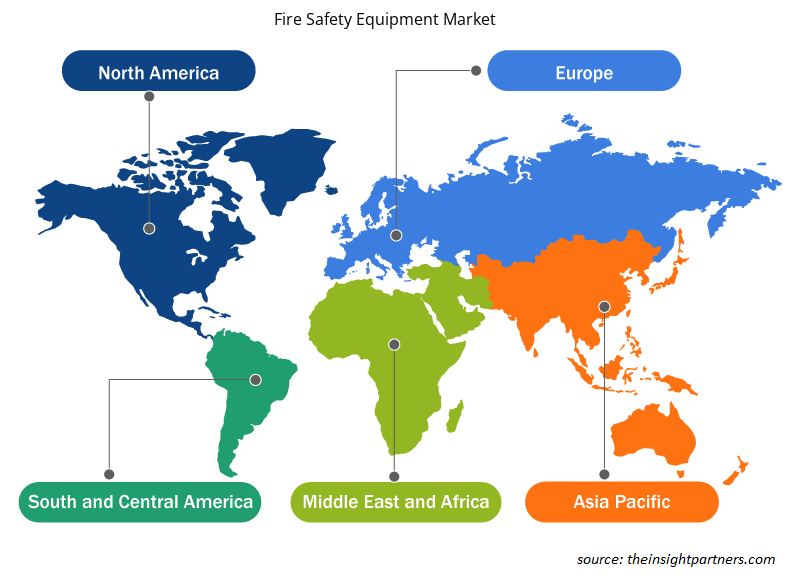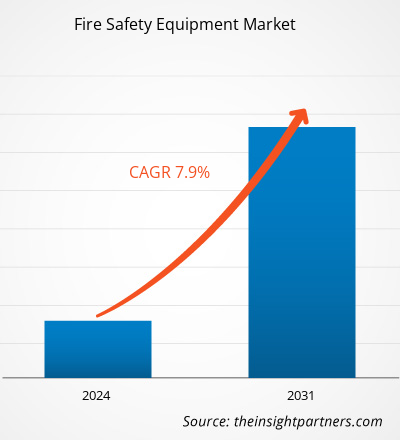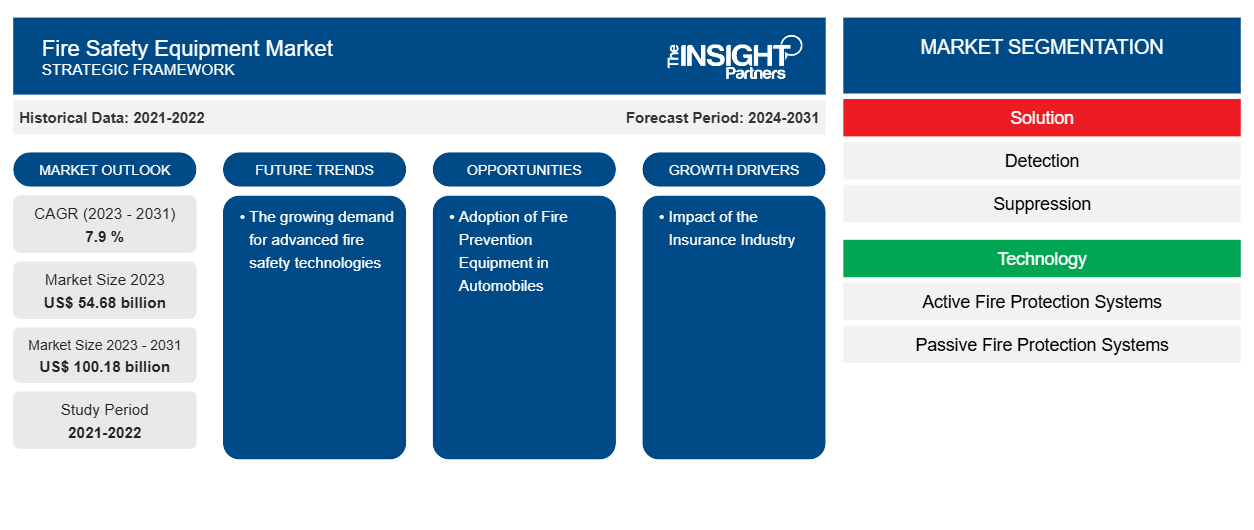Das Marktvolumen für Brandschutzausrüstung soll von 54,68 Milliarden US-Dollar im Jahr 2023 auf 100,18 Milliarden US-Dollar im Jahr 2031 anwachsen. Für den Markt wird für den Zeitraum 2023–2031 eine durchschnittliche jährliche Wachstumsrate (CAGR) von 7,9 % erwartet.Die steigende Nachfrage nach fortschrittlichen Brandschutztechnologien wird voraussichtlich auch weiterhin ein wichtiger Trend auf dem Markt für Brandschutzausrüstung bleiben.
Marktanalyse für Brandschutzausrüstung
Die Umsetzung von Sicherheitsvorschriften für Brandschutz- und Sanierungsprojekte wird das Marktwachstum begünstigen. Technologische Fortschritte wie Wassernebeltechnologien, Rauchmelder und drahtlose Alarmsysteme werden dazu beitragen, diese Zahl weiter zu erhöhen. Es wird erwartet, dass das wachsende Bewusstsein für Brandschutzausrüstung und die möglicherweise katastrophalen Folgen das Marktwachstum vorantreiben werden. Die hohen Ersatzkosten für herkömmliche Feuerlöschausrüstung werden jedoch ein Wachstum des Marktes verhindern.
Marktübersicht für Brandschutzausrüstung
Auch Verbesserungen bei drahtlosen Sensornetzwerken und die zunehmende Nutzung drahtloser Brandmeldegeräte dürften sich positiv auf den Markt auswirken. Der Markt wird voraussichtlich durch zunehmende Entwicklungsaktivitäten in der Gebäudeinfrastruktur sowie ein steigendes Bewusstsein für Brandgefahren beeinflusst. Um die Zahl der Todesfälle zu senken, investieren Organisationen auf der ganzen Welt mehr Geld in die Sicherheit der Infrastruktur. Der weltweite Bedarf an Brandschutzausrüstung wird voraussichtlich steigen, da Bau- und Umbauaktivitäten Brandschutzvorschriften unterliegen . Der Einsatz elektronischer Komponenten in Brandschutzausrüstung hat mit der Weiterentwicklung der Sensortechnologien und der anschließenden Einführung intelligenter drahtloser Systeme dramatisch zugenommen. Diese verbesserten Geräte reagieren schneller auf Notfälle und verfügen über eine höhere Empfindlichkeit. Diese Teile und Systeme sind teuer, da sie aus hochwertigen Materialien und mit hoher Präzision hergestellt werden.
Passen Sie diesen Bericht Ihren Anforderungen an
Sie erhalten kostenlos individuelle Anpassungen an jedem Bericht, einschließlich Teilen dieses Berichts oder einer Analyse auf Länderebene, eines Excel-Datenpakets sowie tolle Angebote und Rabatte für Start-ups und Universitäten.
-
Holen Sie sich die wichtigsten Markttrends aus diesem Bericht.Dieses KOSTENLOSE Beispiel umfasst eine Datenanalyse von Markttrends bis hin zu Schätzungen und Prognosen.
Treiber und Chancen auf dem Markt für Brandschutzausrüstung
Auswirkungen der Versicherungsbranche
Um Risiken und Versicherungskosten zu senken, werden Unternehmen dazu angehalten, in Brandschutzausrüstung zu investieren. Der Grund hierfür sind die von der Versicherungsbranche festgelegten Regeln und Belohnungen für die Installation geeigneter Brandschutzmaßnahmen.
Einführung von Brandschutzausrüstung in Automobilen
Die Integration von Brandschutzsystemen in Automobile, insbesondere in Elektrofahrzeuge, entwickelt sich zu einem wichtigen Treiber für den Markt für Brandschutzausrüstung . Dies ist auf Sicherheitsbedenken in Bezug auf Hochspannungsbatterien zurückzuführen. Daher wird erwartet, dass die Einführung von Brandschutzausrüstung in Automobilen den Akteuren auf dem Markt für Brandschutzausrüstung im Prognosezeitraum neue Möglichkeiten bietet.
Marktbericht zu Brandschutzausrüstung – Segmentierungsanalyse
Wichtige Segmente, die zur Ableitung der Marktanalyse für Brandschutzausrüstung beigetragen haben, sind Lösung, Technologie und Anwendung.
- Basierend auf der Lösung ist der Markt für Brandschutzausrüstung in Erkennung und Unterdrückung segmentiert.
- Nach Technologie ist der Markt in aktive Brandschutzsysteme und passive Brandschutzsysteme segmentiert.
-
Nach Anwendung ist der Markt segmentiert inGewerbe-, Industrie- und Wohngebäude
Das kommerzielle Segment hielt im Jahr 2023 den größten Marktanteil.
Marktanteilsanalyse für Brandschutzausrüstung nach geografischer Lage
Der geografische Umfang des Marktberichts für Brandschutzausrüstung ist hauptsächlich in fünf Regionen unterteilt: Nordamerika, Asien-Pazifik, Europa, Naher Osten und Afrika sowie Südamerika/Süd- und Mittelamerika. Gemessen am Umsatz hatte Nordamerika den größten Marktanteil an Brandschutzausrüstung. Dies ist auf das hohe Bewusstsein für Brandschutz in der Region sowie auf die strengen Brandschutzbestimmungen zurückzuführen, die in der Region durchgesetzt werden.
Regionale Einblicke in den Markt für Brandschutzausrüstung
Die regionalen Trends und Faktoren, die den Markt für Brandschutzausrüstung während des Prognosezeitraums beeinflussen, wurden von den Analysten von Insight Partners ausführlich erläutert. In diesem Abschnitt werden auch die Marktsegmente und die Geografie von Brandschutzausrüstung in Nordamerika, Europa, im asiatisch-pazifischen Raum, im Nahen Osten und Afrika sowie in Süd- und Mittelamerika erörtert.

- Erhalten Sie regionale Daten zum Markt für Brandschutzausrüstung
Umfang des Marktberichts über Brandschutzausrüstung
| Berichtsattribut | Details |
|---|---|
| Marktgröße im Jahr 2023 | 54,68 Milliarden US-Dollar |
| Marktgröße bis 2031 | 100,18 Milliarden US-Dollar |
| Globale CAGR (2023 - 2031) | 7,9 % |
| Historische Daten | 2021-2022 |
| Prognosezeitraum | 2024–2031 |
| Abgedeckte Segmente |
Nach Lösung
|
| Abgedeckte Regionen und Länder |
Nordamerika
|
| Marktführer und wichtige Unternehmensprofile |
|
Marktteilnehmerdichte: Der Einfluss auf die Geschäftsdynamik
Der Markt für Brandschutzausrüstung wächst rasant, angetrieben durch die steigende Nachfrage der Endnutzer aufgrund von Faktoren wie sich entwickelnden Verbraucherpräferenzen, technologischen Fortschritten und einem größeren Bewusstsein für die Vorteile des Produkts. Mit steigender Nachfrage erweitern Unternehmen ihr Angebot, entwickeln Innovationen, um die Bedürfnisse der Verbraucher zu erfüllen, und nutzen neue Trends, was das Marktwachstum weiter ankurbelt.
Die Marktteilnehmerdichte bezieht sich auf die Verteilung der Firmen oder Unternehmen, die in einem bestimmten Markt oder einer bestimmten Branche tätig sind. Sie gibt an, wie viele Wettbewerber (Marktteilnehmer) in einem bestimmten Marktraum im Verhältnis zu seiner Größe oder seinem gesamten Marktwert präsent sind.
Die wichtigsten auf dem Markt für Brandschutzausrüstung tätigen Unternehmen sind:
- Bosch Sicherheitssysteme GmbH
- Eaton Corporation plc
- Gentex Corporation
- Halma plc
- Hochiki Corporation
- Honeywell International, Inc.
Haftungsausschluss : Die oben aufgeführten Unternehmen sind nicht in einer bestimmten Reihenfolge aufgeführt.

- Überblick über die wichtigsten Akteure auf dem Markt für Brandschutzausrüstung
Neuigkeiten und aktuelle Entwicklungen zum Markt für Brandschutzausrüstung
Der Markt für Brandschutzausrüstung wird durch die Erhebung qualitativer und quantitativer Daten nach Primär- und Sekundärforschung bewertet, die wichtige Unternehmensveröffentlichungen, Verbandsdaten und Datenbanken umfasst. Im Folgenden finden Sie eine Liste der Entwicklungen auf dem Markt für Sprach- und Sprechstörungen und Strategien:
- Im September 2022 stellte Johnson Controls, Vorreiter bei der Entwicklung innovativer, nachhaltiger und gesunder Gebäude, mit seiner FireClass-Reihe von Brandmeldegeräten mit offenem Protokoll eine alternative Methode zur Branderkennung vor. Um Bereiche im Brandfall sicherer zu machen, bietet FireClass eine große Auswahl an Lösungen, die von der Branche für den Einsatz in Gewerbe-, Wohn-, Einzelhandels-, Firmen-, Freizeit-, Pflegeheim-, Fertigungs- und Lagerumgebungen zugelassen sind. (Quelle: Johnson Controls, Pressemitteilung)
- Im September 2022 stellte Siemens sein erstes Portfolio an verwalteten und digitalen Brandschutzdiensten auf dem Markt vor. Diese Dienste verknüpfen Brandschutzsysteme mit der Cloud und ermöglichen Unternehmen den Übergang von einem reaktiven, Compliance-gesteuerten Ansatz zu umfassendem Schutz durch intelligente Sicherheit. Durch die kontinuierliche Überwachung des Verschmutzungsgrads der Melder mit Fire Safety Digital Services können Sie sicher sein, dass jeder Brandmelder wie vorgesehen funktioniert und dass externe Risikofaktoren oder die Umgebung die Leistung der Brandschutzsysteme nicht beeinträchtigen. (Quelle: Siemens, Pressemitteilung)
Marktbericht zu Brandschutzausrüstung – Umfang und Ergebnisse
Der Bericht „Marktgröße und Prognose für Brandschutzausrüstung (2021–2031)“ bietet eine detaillierte Analyse des Marktes, die die folgenden Bereiche abdeckt:
- Marktgröße und Prognose auf globaler, regionaler und Länderebene für alle wichtigen Marktsegmente, die im Rahmen des Projekts abgedeckt sind
- Marktdynamik wie Treiber, Beschränkungen und wichtige Chancen
- Wichtige Zukunftstrends
- Detaillierte PEST/Porters Five Forces- und SWOT-Analyse
- Globale und regionale Marktanalyse mit wichtigen Markttrends, wichtigen Akteuren, Vorschriften und aktuellen Marktentwicklungen
- Branchenlandschaft und Wettbewerbsanalyse, einschließlich Marktkonzentration, Heatmap-Analyse, prominenten Akteuren und aktuellen Entwicklungen
- Detaillierte Firmenprofile
- Historische Analyse (2 Jahre), Basisjahr, Prognose (7 Jahre) mit CAGR
- PEST- und SWOT-Analyse
- Marktgröße Wert/Volumen – Global, Regional, Land
- Branchen- und Wettbewerbslandschaft
- Excel-Datensatz
Aktuelle Berichte
Erfahrungsberichte
Grund zum Kauf
- Fundierte Entscheidungsfindung
- Marktdynamik verstehen
- Wettbewerbsanalyse
- Kundeneinblicke
- Marktprognosen
- Risikominimierung
- Strategische Planung
- Investitionsbegründung
- Identifizierung neuer Märkte
- Verbesserung von Marketingstrategien
- Steigerung der Betriebseffizienz
- Anpassung an regulatorische Trends























 Kostenlose Probe anfordern für - Markt für Brandschutzausrüstung
Kostenlose Probe anfordern für - Markt für Brandschutzausrüstung